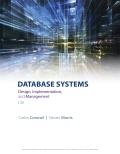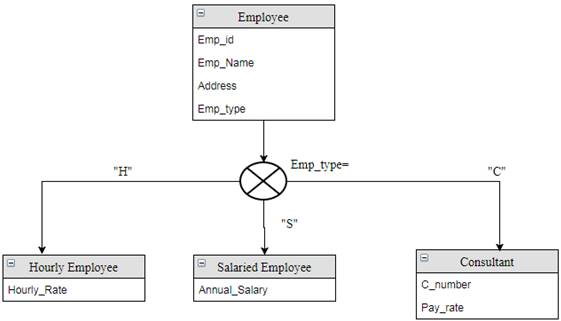
EBK DATABASE SYSTEMS: DESIGN, IMPLEMENT
12th Edition
ISBN: 9781305886841
Author: Morris
Publisher: CENGAGE LEARNING - CONSIGNMENT
expand_more
expand_more
format_list_bulleted
Concept explainers
Expert Solution & Answer
Chapter 5, Problem 1RQ
Explanation of Solution
Entity Supertype:
- The entity supertype is an entity type that has the relation with one or more subtypes and it contains the common attributes of its subtypes.
- The entity subtype is a grouping of entities type in single entity that shares the common attributes or relationships which are different from other grouping.
Use of entity supertype:
The reason for using entity supertype is to reduce redundant relationships and also reduce the number of nulls.
Example:
The following example demonstrates the “supertype” entity, “subtype” entity, and “discriminator”.

Explanation:
- Here, “Employee” entity is a “supertype” entity.
- “Hourly Employee”, “Salaried Employee”, and “Consultant” are the “Sub type” entities.
- “Emp_type” is a discriminator to select appropriate “subtype”.
Want to see more full solutions like this?
Subscribe now to access step-by-step solutions to millions of textbook problems written by subject matter experts!
Students have asked these similar questions
Question D.4: FIFO Page Replacement
Consider the following page reference string:
e, c, b, e, a, g, d, c, e, g, d, a
Considering 4 frames, fill in the following table and then answer how many page faults would occur with the
FIFO page replacement algorithm.
RS: reference string; FO: frame 0, F1: frame 1, etc.
Hint: all frames are initially empty, so your first unique pages will all cost one fault each.
Time
1234567891011
12
RS
e
cb
e agd ce g d
a
FO
F1
F2
F3
Page fault?
b) Total # page faults:
c) Briefly (1-2 sentences) explain Belady's Anomaly that can occur in FIFO Page Replacement.
Consider a system that uses a fixed-partition scheme, with equal partitions of size 2" bytes, and the main
memory has 2¹8 bytes. A process table is maintained with a pointer to the resident partition for each resident
process. How many bits are required for the pointer in the process table? Show all your steps.
Use the same semaphore notation shown above to describe how we can ensure the execution order of the
following process execution graph:
P6
P2
P7
P1
P3
P4
P5
Use all of the following semaphores in your answer:
s1=0; s2=0; s3=0; s4=0; s5=0; s6=0;
Chapter 5 Solutions
EBK DATABASE SYSTEMS: DESIGN, IMPLEMENT
Ch. 5 - Prob. 1RQCh. 5 - What kinds of data would you store in an entity...Ch. 5 - Prob. 3RQCh. 5 - What is a subtype discriminator? Give an example...Ch. 5 - Prob. 5RQCh. 5 - What is the difference between partial...Ch. 5 - Prob. 7RQCh. 5 - According to the data model, is it required that...Ch. 5 - Prob. 9RQCh. 5 - Prob. 10RQ
Ch. 5 - Prob. 11RQCh. 5 - Prob. 12RQCh. 5 - Prob. 13RQCh. 5 - When implementing a 1:1 relationship, where should...Ch. 5 - What is time-variant data, and how would you deal...Ch. 5 - Prob. 16RQCh. 5 - Prob. 1PCh. 5 - Prob. 2PCh. 5 - Prob. 3PCh. 5 - Prob. 4PCh. 5 - Prob. 5PCh. 5 - Prob. 6PCh. 5 - Prob. 7PCh. 5 - Prob. 8CCh. 5 - Prob. 9CCh. 5 - Prob. 10C
Knowledge Booster
Learn more about
Need a deep-dive on the concept behind this application? Look no further. Learn more about this topic, computer-science and related others by exploring similar questions and additional content below.Similar questions
- Consider the set of process: Process ID Arrival Time Burst Time P1 0 5 P2 0 10 P3 + 15 P4 18 10 P5 22 20 a) Draw the GANTT chart for the Round Robin time quantum -5) scheduling algorithm. Use the same implementation you used for the programming assignmenti.e. the processes should always run in PID order. Assume there is no context-switch overhead. Show your work for partial credit. b) Write your answer to the following performance metrics given your above CANTT charts. Show your work for partial credit. Average Response time: Average Wating time: Average Turnaround time:arrow_forwardConsider a file currently consisting of 10 blocks. Assume that the file control block and the new block information to be added are already in memory. Calculate how many disk I/O operations are required for the linked allocation strategy, if, for one block, the following conditions hold: HINTS: 1) ignore disk I/O associated with the file control block. 2) each read and each write is an explicit disk I/O. 3) assume a pointer to the end of the list for linked allocation a. The block is added at the beginning. b. The block is added in the middle. c. The block is added at the end. d. The block is removed from the beginning. e. The block is removed from the middle. f. The block is removed from the end.arrow_forwardSegment Base (original) Length Base (after compaction) 0 100 300 1 1400 600 2 450 100 3 3200 80 4 2200 500 5 3300 33 1. Given the original base addresses, what are the physical addresses for the following logical addresses? If it's an invalid address, just write "invalid". Note that (X, Y) => segment X, offset Y a) (0,350) b) (1,599) c) (2,50) d) (3,81) e) (4,300) f) (5.0) g) (5,34)arrow_forward
- Process Allocation A Max BCDABC D A Available B C PO 3 0 2 1 4 2 4 2 1 0 0 P1 0 1 0 1 0 2 2 2 P2 1 2 0 0 3 2 1 0 P3 0 1 1 2 1 1 1 2 P4 0 0 1 1 1 - 0 2 1 a) What is the content of the matrix Need? Process PO P1 P2 P3 P4 A Need BC D D ° b) Is the system in a safe state? If yes, give a safe sequence of processes. If not, explain why the system is not in a safe state. c) If a request from process P4 arrives for (1,0,0,0), can the request be granted immediately? Please state the reason.arrow_forwardConsider N processes sharing the CPU in a round-robin fashion (N>=2). Assume that each context switch takes S ms and that each time quantum is Q ms. For simplicity, assume that processes never block on any event and simply switch between the CPU and the ready queue. Also, assume that a process is still in the ready queue while a context switch is happening. a) What happens if Q is much smaller than S? What happens when Q→→ ∞, i.e. is much larger than the maximum turnaround time of all the processes? Be brief (1-2 sentences max) in your answer. b) If you use RR for scheduling, which of the three performance metrics (waiting, response, turnaround time) is more likely to be improved? Why (1-2 sentences max)?arrow_forwardCompute the jackknife estimate of bias and standard error for the correlation statistics from the law82 data using r languagearrow_forward
- Question D.1: Effective Access Time A computer keeps its page tables in memory. Memory access time is 100 nanoseconds (ns). Answer the following questions about the performance of this setup. Show your work. a) What is the effective access time (i.e. reading a word in memory) with no caching and a two-level page table? b) Consider the above scenario but with a TLB having a cache hit rate of 98%. If the TLB takes 20 ns to access, what is the effective access time of this setup when considering this TLB?arrow_forwardThe data law82 in bootstrap library contains LSAT and GPA for 82 law schools. 1. Write you own R code to estimate the correlation between LSAT and GPA scores, and compute the bootstrap estimate of the standard error and bias of the sample correlation. 2. Use the boot function in boot library to compute the bootstrap estimate of the standard error and bias of the sample correlation. Compare your results in 1 with the function output. using r languagearrow_forwardi would like to get help to resolve the following casearrow_forward
- Challenge: Assume that the assigned network addresses are correct. Can you deduce (guess) what the network subnet masks are? Explain while providing subnet mask bits for each subnet mask. [Hint: Look at the addresses in binary and consider the host ids]arrow_forwardWhat is the main difference between Static routing and Dynamic routing (OSPF)? in terms of either wildcard mask or subnet mask, or especially for increasing the number of networks, explaining the reason while providing a specific example like what command they use in CLIarrow_forwardAdd a new class Checking Account that inherits from the BankAccount class, and has a double instance variable overdraftLimit in addition to the variables inherited from the superclass. Create a constructor for the Checking Account class that takes in the account number, account holder name, initial balance, account type and overdraft limit as input, and uses the super keyword to call the constructor of the superclass, passing in the account number, account holder name and initial balance, account type. Re-write the withdraw() method in the CheckingAccount class so that it first checks if the withdrawal amount is less than the current balance plus the overdraft limit. If it is, the withdrawal is allowed and the balance is updated. If not, the method should return an error message "Insufficient funds". Create a new method displayOverdraft Limit() that returns the overdraft limit of the Checking Account. In the BankAccountTest class, create a new object of type Checking Account with…arrow_forward
arrow_back_ios
SEE MORE QUESTIONS
arrow_forward_ios
Recommended textbooks for you
 Database Systems: Design, Implementation, & Manag...Computer ScienceISBN:9781285196145Author:Steven, Steven Morris, Carlos Coronel, Carlos, Coronel, Carlos; Morris, Carlos Coronel and Steven Morris, Carlos Coronel; Steven Morris, Steven Morris; Carlos CoronelPublisher:Cengage Learning
Database Systems: Design, Implementation, & Manag...Computer ScienceISBN:9781285196145Author:Steven, Steven Morris, Carlos Coronel, Carlos, Coronel, Carlos; Morris, Carlos Coronel and Steven Morris, Carlos Coronel; Steven Morris, Steven Morris; Carlos CoronelPublisher:Cengage Learning
 Database Systems: Design, Implementation, & Manag...Computer ScienceISBN:9781305627482Author:Carlos Coronel, Steven MorrisPublisher:Cengage Learning
Database Systems: Design, Implementation, & Manag...Computer ScienceISBN:9781305627482Author:Carlos Coronel, Steven MorrisPublisher:Cengage Learning Principles of Information Systems (MindTap Course...Computer ScienceISBN:9781285867168Author:Ralph Stair, George ReynoldsPublisher:Cengage Learning
Principles of Information Systems (MindTap Course...Computer ScienceISBN:9781285867168Author:Ralph Stair, George ReynoldsPublisher:Cengage Learning Fundamentals of Information SystemsComputer ScienceISBN:9781305082168Author:Ralph Stair, George ReynoldsPublisher:Cengage Learning
Fundamentals of Information SystemsComputer ScienceISBN:9781305082168Author:Ralph Stair, George ReynoldsPublisher:Cengage Learning A Guide to SQLComputer ScienceISBN:9781111527273Author:Philip J. PrattPublisher:Course Technology Ptr
A Guide to SQLComputer ScienceISBN:9781111527273Author:Philip J. PrattPublisher:Course Technology Ptr

Database Systems: Design, Implementation, & Manag...
Computer Science
ISBN:9781285196145
Author:Steven, Steven Morris, Carlos Coronel, Carlos, Coronel, Carlos; Morris, Carlos Coronel and Steven Morris, Carlos Coronel; Steven Morris, Steven Morris; Carlos Coronel
Publisher:Cengage Learning


Database Systems: Design, Implementation, & Manag...
Computer Science
ISBN:9781305627482
Author:Carlos Coronel, Steven Morris
Publisher:Cengage Learning

Principles of Information Systems (MindTap Course...
Computer Science
ISBN:9781285867168
Author:Ralph Stair, George Reynolds
Publisher:Cengage Learning

Fundamentals of Information Systems
Computer Science
ISBN:9781305082168
Author:Ralph Stair, George Reynolds
Publisher:Cengage Learning

A Guide to SQL
Computer Science
ISBN:9781111527273
Author:Philip J. Pratt
Publisher:Course Technology Ptr